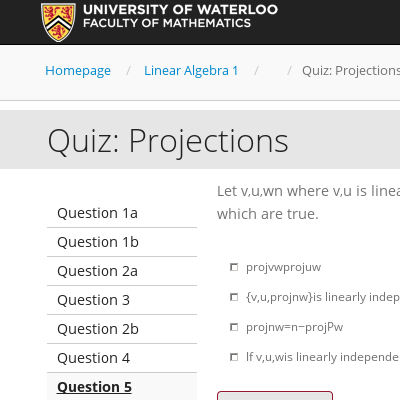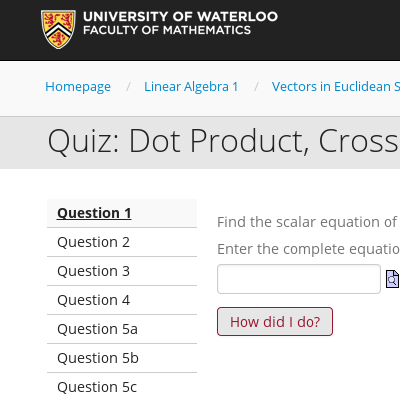A matrix-vector product (Definition MVP) is a linear combination of the columns of the matrix and this allows us to connect matrix multiplication with systems of equations via Theorem SLSLC. Row operations are linear combinations of the rows of a matrix, and of course, reduced row-echelon form (Definition RREF) is also intimately related to solving systems of equations. In this section we will formalize these ideas with two key definitions of sets of vectors derived from a matrix.
- License
- GFDL-1.2
- Submitted At
- September 11th, 2017
- 7 years ago
- Views
- 2
- Type
- Textbook
- Language
- English
- Content Type
- text/html
A matrix-vector product (Definition MVP) is a linear combination of the columns of the matrix and this allows us to connect matrix multiplication with systems of equations via Theorem SLSLC. Row operations are linear combinations of the rows of a matrix, and of course, reduced row-echelon form (Definition RREF) is also intimately related to solving systems of equations. In this section we will formalize these ideas with two key definitions of sets of vectors derived from a matrix.
- License
- GFDL-1.2
- Submitted At
- September 11th, 2017
- 7 years ago
- Views
- 3
- Type
- Textbook
- Language
- English
- Content Type
- text/html
A matrix-vector product (Definition MVP) is a linear combination of the columns of the matrix and this allows us to connect matrix multiplication with systems of equations via Theorem SLSLC. Row operations are linear combinations of the rows of a matrix, and of course, reduced row-echelon form (Definition RREF) is also intimately related to solving systems of equations. In this section we will formalize these ideas with two key definitions of sets of vectors derived from a matrix.
- License
- GFDL-1.2
- Submitted At
- September 11th, 2017
- 7 years ago
- Views
- 4
- Type
- Textbook
- Language
- English
- Content Type
- text/html
A matrix-vector product (Definition MVP) is a linear combination of the columns of the matrix and this allows us to connect matrix multiplication with systems of equations via Theorem SLSLC. Row operations are linear combinations of the rows of a matrix, and of course, reduced row-echelon form (Definition RREF) is also intimately related to solving systems of equations. In this section we will formalize these ideas with two key definitions of sets of vectors derived from a matrix.
- License
- GFDL-1.2
- Submitted At
- September 11th, 2017
- 7 years ago
- Views
- 3
- Type
- Textbook
- Language
- English
- Content Type
- text/html
A matrix-vector product (Definition MVP) is a linear combination of the columns of the matrix and this allows us to connect matrix multiplication with systems of equations via Theorem SLSLC. Row operations are linear combinations of the rows of a matrix, and of course, reduced row-echelon form (Definition RREF) is also intimately related to solving systems of equations. In this section we will formalize these ideas with two key definitions of sets of vectors derived from a matrix.
- License
- GFDL-1.2
- Submitted At
- September 11th, 2017
- 7 years ago
- Views
- 3
- Type
- Textbook
- Language
- English
- Content Type
- text/html
A matrix-vector product (Definition MVP) is a linear combination of the columns of the matrix and this allows us to connect matrix multiplication with systems of equations via Theorem SLSLC. Row operations are linear combinations of the rows of a matrix, and of course, reduced row-echelon form (Definition RREF) is also intimately related to solving systems of equations. In this section we will formalize these ideas with two key definitions of sets of vectors derived from a matrix.
- License
- GFDL-1.2
- Submitted At
- September 11th, 2017
- 7 years ago
- Views
- 3
- Type
- Textbook
- Language
- English
- Content Type
- text/html
Properties of matrix inversion: inverse of the inverse, inverse of the transpose, inverse of a product; elementary matrices and corresponding row operations; a matrix is invertible if and only if it is row-equivalent to the identity matrix; row-reduction algorithm for computing matrix inverse
- Created On
- August 25th, 2017
- 7 years ago
- Views
- 3
- Type
- Video
- Language
- English
- Content Type
- text/html; charset=utf-8
Associative and distributive properties of matrix multiplication and addition; multiplication by the identity matrix; definition of the transpose of a matrix; transpose of the transpose, transpose of a sum, transpose of a product
- Created On
- August 25th, 2017
- 7 years ago
- Views
- 2
- Type
- Video
- Language
- English
- Content Type
- text/html; charset=utf-8
Learning goals: 1. What are the dimension (size) requirements for two matrices so that they can be multiplied to each other? 2. What is the product of two matrices, when it exists?
- Created On
- February 17th, 2017
- 7 years ago
- Views
- 2
- Type
- Video
- Timeframe
- Review
- Language
- English
- Content Type
- text/html; charset=utf-8
This is a quiz from the University of Waterloo. It is a quiz about projections that is strictly in R^n. It additionally asks questions on perpendicular vectors and cross products.
- Created On
- October 23rd, 2013
- 11 years ago
- Views
- 2
- Type
- Unknown
- Timeframe
- Post-class
- Perspective
- Example
- Language
- English
- Content Type
- text/html;charset=UTF-8
Quiz from the University of Waterloo. This is intended to be used after the video of the same name.
math.la.d.vec.unit.coord
math.la.d.distance.coord
math.la.d.vec.norm.coord
math.la.t.innerproduct.self.z.coord
math.la.t.innerproduct.commutative.scalar.real.coord
math.la.t.innerproduct.distributive.coord
math.la.t.innerproduct.commutative.coord
math.la.d.innerproduct.real.coord
math.la.d.vec.orthogonal
- Created On
- October 23rd, 2013
- 11 years ago
- Views
- 3
- Type
- Unknown
- Timeframe
- Post-class
- Perspective
- Example
- Language
- English
- Content Type
- text/html;charset=UTF-8
Definition of sum of matrices, product of a scalar and a matrix
- Created On
- February 17th, 2017
- 7 years ago
- Views
- 3
- Type
- Video
- Timeframe
- Pre-class
- Perspective
- Introduction
- Language
- English
- Content Type
- text/html; charset=utf-8
Orthonormal sets and bases (definition); expressing vectors as linear combinations of orthonormal basis vectors; matrices with orthonormal columns preserve vector norm and dot product; orthogonal matrices; inverse of an orthogonal matrix equals its transpose
- Created On
- August 25th, 2017
- 7 years ago
- Views
- 3
- Type
- Video
- Language
- English
- Content Type
- text/html; charset=utf-8
This is a video from the University of Waterloo. Dot Product, Cross-Product in R^n (which should be in Chapter 8 section 4 about hyperplanes.
math.la.d.vec.norm.coord
math.la.d.innerproduct.real.coord
math.la.t.innerproduct.commutative.coord
math.la.t.innerproduct.distributive.coord
math.la.t.innerproduct.commutative.scalar.real.coord
math.la.t.innerproduct.self.z.coord
math.la.d.vec.subspace.orthogonal
math.la.d.vec.orthogonal
math.la.d.vec.unit.coord
math.la.d.crossproduct
- Created On
- October 23rd, 2013
- 11 years ago
- Views
- 3
- Type
- Video
- Perspective
- Introduction
- Language
- English
- Content Type
- text/html;charset=UTF-8
A matrix-vector product (Definition MVP) is a linear combination of the columns of the matrix and this allows us to connect matrix multiplication with systems of equations via Theorem SLSLC. Row operations are linear combinations of the rows of a matrix, and of course, reduced row-echelon form (Definition RREF) is also intimately related to solving systems of equations. In this section we will formalize these ideas with two key definitions of sets of vectors derived from a matrix.
- License
- GFDL-1.2
- Submitted At
- September 11th, 2017
- 7 years ago
- Views
- 3
- Type
- Textbook
- Language
- English
- Content Type
- text/html
A rotatable model of the cross product of two vectors.
- License
- CC-BY-SA-4.0
- Created On
- August 7th, 2018
- 6 years ago
- Views
- 2
- Type
- Applet
- Language
- English
- Content Type
- text/html; charset=utf-8
Inner product of two vectors in R^n, length of a vector in R^n, orthogonality. Motivation via approximate solutions of systems of linear equations, definition and properties of inner product (symmetric, bilinar, positive definite); length/norm of a vector, unit vectors; definition of distance between vectors; definition of orthogonality; Pythagorean Theorem.
- Created On
- August 22nd, 2017
- 7 years ago
- Views
- 2
- Type
- Video
- Language
- English
- Content Type
- text/html; charset=utf-8
Determinant of the transpose equals the determinant of the original matrix; rescaling a column rescales the determinant by the same factor; interchanging two columns changes the sign of the determinant; adding multiple of one column to another leaves determinant unchanged; determinant of the product of two matrices equals product of the two determinants
- Created On
- August 25th, 2017
- 7 years ago
- Views
- 3
- Type
- Video
- Language
- English
- Content Type
- text/html; charset=utf-8
The product of a matrix times a vector is defined, and used to show that a system of linear equations is equivalent to a system of linear equations involving matrices and vectors. The example uses a 2x3 system.
- License
- CC-BY-SA-4.0
- Created On
- February 15th, 2017
- 7 years ago
- Views
- 3
- Type
- Video
- Timeframe
- Pre-class
- Perspective
- Introduction
- Language
- English
- Content Type
- text/html; charset=utf-8











